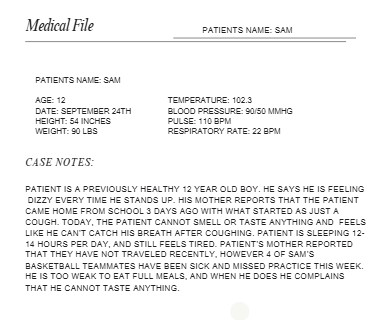How many vital signs do we have?
4
Blood pressure is...
The amount of force it takes to push blood out to the body.
BPM stands for:
Beats per minute
Temperature is known as...
The amount of heat your body produces
Respiratory Rate is....
The amount of breaths you take in 1 minute.
Why is it important to interview a patient before treating them?
To get a better understanding of what is wrong - their symptoms and to know what to test.
What are the four vital signs?
Pulse, blood pressure, respiratory rate and temperature
How many numbers are in blood pressure readings?
2.
True or false: you do NOT use your thumb to take pulse
True
Describe what a fever is.
Body temperature that is higher than 99.9 degrees, this shows an indication of an infection or an illness.
Create an example of 1 way you can cause your respiratory rate to rise.
Exercise, stress, excitement
What are symptoms?
Signs of sickness / disease or injury
Create a definition for vital signs
Measurements that tell the state of a patients essential bodily functions
If you eat too much of this food, your blood pressure will rise.
Salt
True or false: a pulse reading of 120bpm after working out for 30 minutes is considered to be healthy.
True.
True or false: exercise can cause your temperature to rise.
False
Describe how you take someone's respiratory rate.
Seated, relaxed with their feet flat on the floor. Count the amount of times you see their chest rise and fall for 1 minute.
Define the term "diagnosis"
Finding the medical problem or cause of a patient's illness.
Identify the healthy vital sign readings for each of the vital signs
Pulse: 60-100 beats per minute
Temperature: 97.8-99.9 degrees farenheit
Blood Pressure: 90/60-120/80mmHG
Respiratory Rate: 12 - 18 breaths per minute
A patient has a blood pressure reading of 70/45mmHG. What are they likely feeling?
Dizzy when they stand up, weak, tired.
Where on the body can you find pulse rate?
Wrist or neck
Your body temperature is considered healthy if readings are between these two numbers.
97.8-99.9 degrees Fahrenheit
Identify the independent variable for an experiment about jumping jacks and its impact on breathing
Performing jumping jacks for 2 minutes (independent = the investigation)
Provide 3 symptoms for someone who has food poisoning.
Fever
Diarrhea
The healthy vital sign readings are considered to be which type of variable?
Control variable - because we compare our vital sign readings to these healthy averages.
Seated with feet flat on the floor, rested.
Use a blood pressure cuff to put around the patients arm, above the elbow.
How long should you time to take someone's pulse? What number do you need to multiply that count by?
15 seconds and multiply that by 4.
If someones temperature reads as 101.3 degrees, this is an indication they might have...
Breathing rate AFTER performing jumping jacks for 2 minutes.
Look at the chart. What are the patients vital signs? 
Temperature: 102.3 degrees
Blood Pressure: 90/50mmHG
Pulse: 110BPM
Respiratory Rate: 22BPM